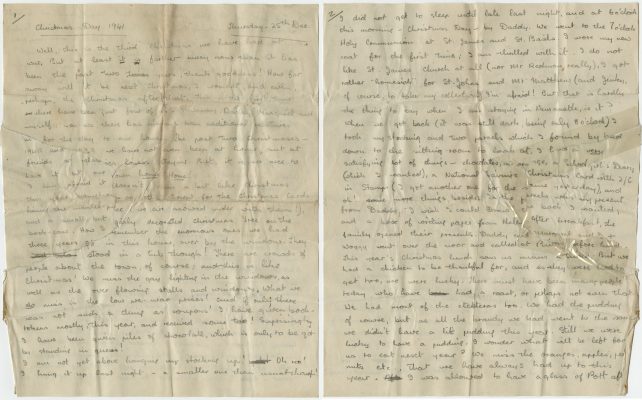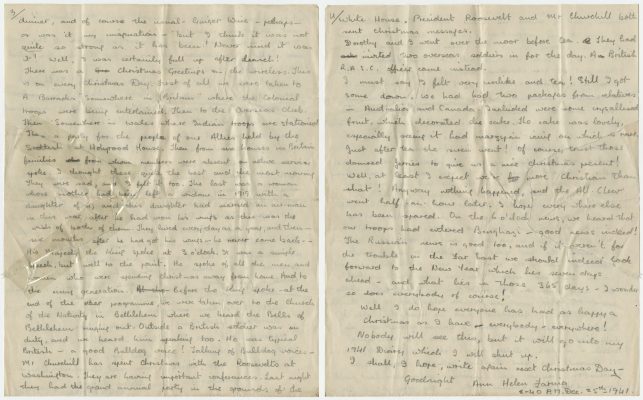Christmas Diary of Ann Helen Farina, 1941
Reference: NRO/07896/2
Suggested age groups: KS1, KS2, KS3, KS4, Lifelong Learners
Subject areas: WW2
CONTEXT
Ann Farina was a school girl in Gosforth when the Second World War broke out. She attended Newcastle Central High School for Girls and was evacuated to Keswick along with the rest of the school. Her evacuation diary can also be found on this site. These pages record her experience of Christmas during war time in Gosforth with her family, when she was 13 years old.
On the first page she compares their small Christmas tree to the large one that they had before the war. She also complains about rationing and having to use coupons to buy presents. She says that she misses the Christmas lights in town (Newcastle), but is pleased to have been given lots of chocolate.
The second page describes Christmas morning. The family go to church, have breakfast and then open their presents. Ann lists her presents, including an orange! They then have lunch – Ann bemoans not having a turkey, but admits that they are lucky to get a chicken.
Ann goes into detail about the wireless [radio] programmes that the family listen to together on page 3. She mentions Churchill and his “Bulldog voice” towards the bottom of the page. On page 4 she describes having tea (although rather full) and is very pleased with the Christmas cake, especially as marzipan is “rare”. After tea, the air raid siren sounded so the family had to get into a shelter. The “all clear” was sounded half an hour later.
ACTIVITIES
ACTIVITY 1
Background
Ann Farina was a school girl in Gosforth when the Second World War broke out. She attended Newcastle Central High School for Girls and was evacuated to Keswick along with the rest of the school. On the first page she compares their small Christmas tree to the large one that they had before the war. She also complains about rationing and having to use coupons to buy presents. She says that she misses the Christmas lights in town (Newcastle), but is pleased to have been given lots of chocolate.
SEE
See: Who is Ann Farina?
See: Where did Ann live before she was evacuated?
See: Where did Ann go to school?
See: Which town was Ann evacuated to?
See: Which holiday is Ann celebrating in this diary?
See: How many Christmases does Ann say they have had ‘at war’?
See: Where did Ann spend Christmas?
See: Who did Ann spend Christmas with?
See: Where did Ann spend the previous two Christmases?
See: What did Ann say she had mostly given as Christmas gifts?
See: What did Ann say she received as gifts?
THINK
Think: What impression does the diary give you of Ann?
Think: How old did you think Ann was after reading her diary? Does she come across as the age she is, older or younger?
Think: What do you think Ann’s life was like before being evacuated? Can you tell what her social class was?
Think: Why does Ann emphasise that she spent Christmas at home?
Think: What was rationing?
Think: Why did Ann pay using coupons?
Think: Why did prices increase during wartime?
Think: Why were there less Christmas lights and shopping stalls in Newcastle than in the pre-war years?
Think: Compare this diary entry to Ann’s diary entry from September 1939 (NRO/07896/2). Do you think Ann has changed over the two years?
DO
Do: Research the foods and their quantities that were available during rationing and use this to create a Christmas meal menu for a family of 4. Is this different to the Christmas meal that a family of 4 might eat today?
Do: Look at the wartime Christmas recipes on the Recipes Past and Present website – can you have a go at making a wartime Christmas recipe?
Do: Create a rationing coupon book.
Do: Design a wartime Christmas card.
Do: Look at the Imperial War Museum’s collection of Second World War posters. Have a go at making a rationing poster.
Do: Do you think rationing had a social impact on Britain? In groups debate how rationing impacted British views on social class.
Do: What else led to social change during the Second World War? Create a presentation highlighting rationing and one other aspect of the Second World War that led to social change.
Resources
https://www.youtube.com/watch?v=ZPs8hbksOg8
https://www.iwm.org.uk/history/the-evacuated-children-of-the-second-world-war
https://www.bbc.co.uk/teach/school-radio/history-ks2-world-war-2-clips-ww2-evacuation-index/zvs3scw
https://www.bbc.co.uk/bitesize/guides/z6ctyrd/revision/5
https://www.iwm.org.uk/history/what-you-need-to-know-about-rationing-in-the-second-world-war
https://www.bbc.co.uk/bitesize/guides/z6ctyrd/revision/3
https://www.historic-uk.com/CultureUK/Christmas-in-World-War-Two/
https://www.bbc.co.uk/programmes/articles/1gc5PW8KNF9RWbx6Y7zfgS/christmas-menu
https://www.warhistoryonline.com/world-war-ii/5-ways-rationing-affected-christmas-ww2.html
http://www.recipespastandpresent.org.uk/wartime/tag/christmas/
https://www.iwm.org.uk/learning/resources/second-world-war-posters
ACTIVITY 2
Background
The second page describes Christmas morning. The family go to church, have breakfast and then open their presents. Ann lists her presents, including an orange! They then have lunch – Ann bemoans not having a turkey, but admits that they are lucky to get a chicken.
Ann goes into detail about the wireless [radio] programmes that the family listen to together on page 3. She mentions Churchill and his “Bulldog voice” towards the bottom of the page.
On page 4 she describes having tea (although rather full) and is very pleased with the Christmas cake, especially as marzipan is “rare”. After tea, the air raid siren sounded so the family had to get into a shelter. The “all clear” was sounded half an hour later.
SEE
See: What did Ann do on Christmas Day?
See: What happened just after tea?
See: What is a wireless?
See: What did Ann listen to on the wireless?
THINK
Think: Compare Ann’s Christmas experience to your own experience of celebrating a holiday. How would the differences affect the celebration?
Think: Why might Ann have felt homesick going to St James’ Church rather than St John’s?
Think: How does Ann’s description of the air raid siren going off make you feel? How do you think Ann and her family felt about it?
DO
Do: Ann described the soldier and Winston Churchill as having “bulldog” voices. What does a bulldog voice sound like? Can you speak in a bulldog voice?
Do: Think about how your voice sounds. What words would you use to describe it?
Do: Think about having to communicate using only your voice with no visual aids. Close your eyes and have a conversation. Do you have to change your tone to express things you would otherwise express with your facial expressions or body movements?
Do: Imagine you are on one of the Christmas Greetings radio programmes that Ann mentions. Write a script for the programme and then record it.
Do: Think about all of the different sounds that Ann might have heard around her on Christmas Day 1941. Create an interpretive piece of music inspired by what Ann might have heard.
OTHER ONLINE RESOURCES
Evacuation
Imperial War Museum website, page about child evacuation: https://www.iwm.org.uk/history/the-evacuated-children-of-the-second-world-war
YouTube website, British Pathe film of children being evacuated: https://www.youtube.com/watch?v=ZPs8hbksOg8
BBC Teach website, includes radio report of evacuation and interviews with children and host families: https://www.bbc.co.uk/teach/school-radio/history-ks2-world-war-2-clips-ww2-evacuation-index/zvs3scw
BBC website, an archive of Second World War memories from Tyneside and Northumberland: https://www.bbc.co.uk/history/ww2peopleswar/categories/c1156/index_6.shtml
Rationing
Imperial War Museum website, page about rationing during the Second World War: https://www.iwm.org.uk/history/what-you-need-to-know-about-rationing-in-the-second-world-war
BBC Bitesize website, page about rationing: https://www.bbc.co.uk/bitesize/guides/z6ctyrd/revision/3
Radio
BBC Teach website, page of WW2 radio speeches: https://www.bbc.co.uk/teach/school-radio/history-ks2-world-war-2-clips-ww2-speeches-index/zmmhmfr
Air Raids
The National Archives education website, page about building a bomb shelter: https://www.nationalarchives.gov.uk/education/resources/build-bomb-shelter/
BBC Teach website, page of sounds related to air raids: https://www.bbc.co.uk/teach/school-radio/history-ks2-world-war-2-clips-ww2-sounds-index/z4b4bdm



